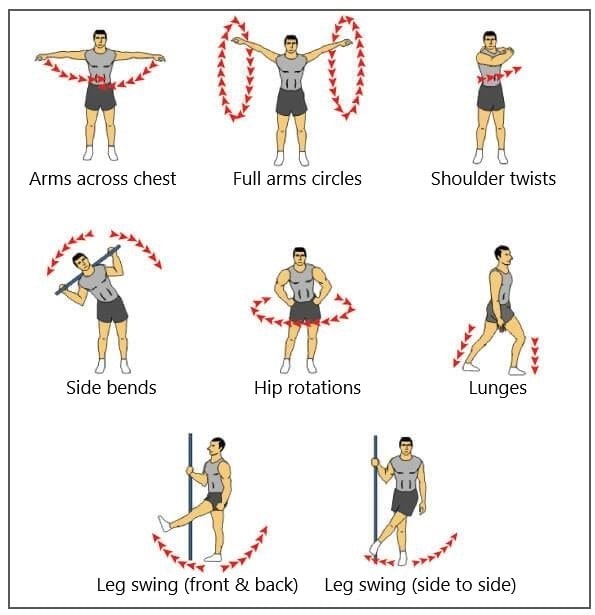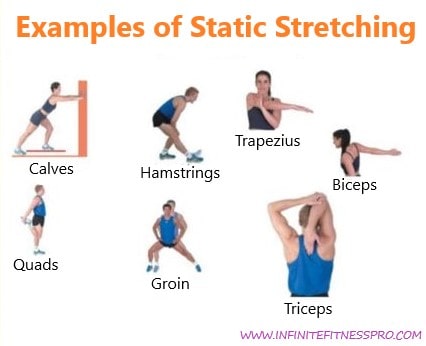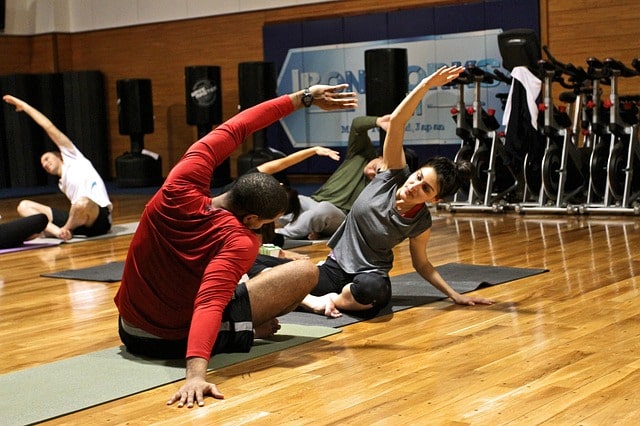When it comes to stretching, you must know the difference in dynamic stretching vs static stretching.
Stretching is very essential for good health and provides several benefits including muscle toning, flexibility, and joint mobility. However, some lifters don’t include stretching in their workout routine due to which their flexibility reduces over time.
Stretching is of different types – static, dynamic, ballistic, and proprioceptive neuromuscular facilitation (PNF stretching). In this article, we will focus on dynamic stretching vs static stretching. So let’s get started.
What is Dynamic Stretching?
Dynamic stretching includes those body movements in which your muscles and joints go through a full range of motion, for example, walking lunges, arm rotation, leg swings. etc.
Dynamic stretching is done in order to get your body moving. You don’t need to hold these stretches. These stretches sometimes mimic the exercise or activity you are gonna perform.
You should do it prior to your workout or any sports activity. These stretches help your muscles in warming up and prepare them for exercises.
Here are some examples of dynamic stretching:

What is Static Stretching?
Static stretching includes stretches in which you hold a stretch position for some period of time. Usually between 30 to 60 seconds.
Unlike dynamic stretching, static stretching doesn’t involve the continuous movement of your joints and muscles. Static stretching is very effective in increasing your flexibility and range of motion.
There are different static stretches for different muscle groups. Here are some of the examples of static stretching:

READ MORE- Static stretching routine for beginners
Dynamic Stretching Vs Static Stretching
Dynamic and static, both type of stretching techniques have their own benefits and timings to do. Let’s discuss about some key differences between them in various aspects:
When to do which type of stretching
Dynamic stretching should be done before the workout or any sports activity whereas, static stretching comes at the end.
Dynamic stretching is important for warming up and static stretches are good during cooling down.
You must do dynamic and static stretching before and after the workout respectively for at least 5-10 minutes. It prepares your muscles and joints for heavy exercises and improves your performance and flexibility.
However, in the gym, I see a lot of people don’t give much emphasis on stretching.
They often do weight training and cardio with full focus but ignores stretching. Due to which they become more prone to injuries and tend to reduce their performance and flexibility in the long run.
Benefits of Dynamic Stretching
Including dynamic stretching in your warm-up before the workout provides various benefits. These benefits won’t let you skip dynamic stretching before an intense workout session.
Boosts athletic performance
Dynamic stretching is an effective and proven way to boost your workout performance. It helps in preparing your muscles and joints for a demanding workout.
Studies also show that dynamic stretching before the workout helps in making a better mind-muscle connection.
A study published in the British Journal of Sports Medicine says that dynamic stretching enhances power and strength performance. On the other hand, static stretching before the workout doesn’t provide such benefit, instead, it may also reduce strength.
Lower risk of injury
Dynamic stretching is done to warming you up before a workout. In addition to muscles, it also stretches your joints and ligaments. Lifting heavy weights without doing proper warm-up can make you more prone to injuries.
A 2008 study in The BMJ found that a proper warm-up routine that includes running, dynamic stretching, and targeted exercises decreases the overall risk of injury by about 35%.
Hence, it is very beneficial to add dynamic stretching in your warm-up routine before an intense workout session.
You must have read: How To Do Warm-up Before A Workout
Greater range of motion
The range of motion is the distance in which a joint can comfortably move in a particular direction.
Several studies show that dynamic stretching effectively helps you in giving a better range of motion.
Benefits of Static Stretching
If you don’t stretch after the workout, you may miss some of these benefits.
Better flexibility and range of motion
Static stretching at the end of the workout gives better flexibility and range of motion. A 2018 study shows that static stretching effectively increases the range of motion (ROM).
In the long run, weight training can reduce the flexibility of your muscles and the range of motion of your joints. Hence, stretching at the end of your workout is always beneficial.
Reduces muscle soreness and stiffness
Research shows that static stretching reduces the muscle stiffness and pain caused due to an intense workout session.
Stretching after the workout also helps in relaxing the muscles which further reduces muscle tension and tightness.
Faster recovery
A 2018 study shows that daily stretching enhances blood flow in your muscles. More blood flow means more nutrition and faster recovery of fatigued muscles.
In addition, less muscle also helps in better recovery.
Improves performance
Static stretching improves flexibility of your muscles which enhances, agility, and speed. These things can help you in improving your athletic and sports performance.
Precautions and Safety Tips
Though stretching exercises are very safe but still, here are some of the precautions and safety measures you should take.
For dynamic stretching
- Do some cardio exercises first: Before starting dynamic stretching, it is better to fasten your heart rate and increase blood flow. You can do it with some cardiovascular exercises like brisk walking, running, jumping, etc.
- Don’t do too much: 10 to 20 sets per exercise are sufficient. You don’t need to go beyond that.
- Take rest if you are injured: In the case of joint pain or any type of injury, you should avoid dynamic stretching exercises.
- Static stretches are better for flexibility: If you are going to do the exercises that require flexibility like yoga or gymnastics, then static stretching would be better than dynamic.
For static stretching
- Don’t hold your stretch for very long: A 30 to 60 seconds hold is enough for most people. Don’t go beyond that unless you are an experienced gymnast.
- Be smooth and slow: Be nice and gentle while performing static stretches. Doing them in a hurry may lead to injuries.
- Keep breathing: Don’t forget to breathe during the stretch. Breathing helps in relieving stress and tension from your body.
- Understand your limits: Start with a few stretches for short. Increase the number of stretches and stretch time as you gain experience and flexibility.
Dynamic Vs Static Stretching – Summary
So this was the detailed research-based article explaining dynamic vs static stretching. Here are the key points:
- Dynamic stretching includes movements that keep your body moving whereas in static stretching you hold a stretch for some period of time.
- Dynamic stretching prepares your muscles and joints for the main workout or sports activity. On the other hand, static stretching relaxes and reduces stress and tension from your muscles.
- Dynamic stretching is important for warming you up whereas static stretching is for cooling you down.
- Dynamic stretching boosts workout performance and reduces the risk of injury. Static stretching improves flexibility, ROM, and reduces muscle pain and stiffness.
Thanks for reading this far. I hope you like the article and learned something from this.
If you have any query related to fitness, just leave a comment below.




